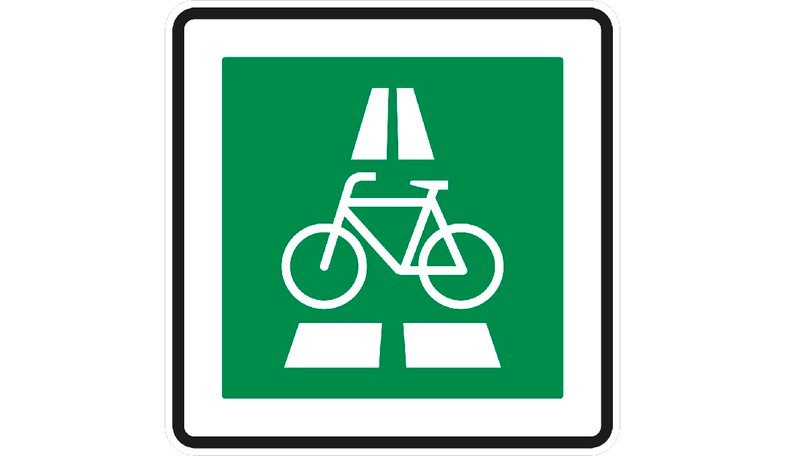Cycle superhighways help cyclists to reach their destination quickly and safely
Cycle superhighways are putting cyclists on the fast track. Cycle superhighways are routes with special construction standards and are exclusively reserved for cyclists so that they can reach their destination quickly and safely. They have a generous width, are well lit and, with only few exceptions, can be used without having to stop. Additionally, cycle superhighways can contribute to reducing negative impacts of road transport, such as noise and emissions, and have a positive impact on the climate.
In the period from 2017 until the end of 2030, the Federal Government is providing financial assistance for the planning and construction of cycle superhighways under the responsibility of the federal states and local authorities. A total of 22 million euros has been made available for this purpose in the 2025 financial year. The eligibility criteria are laid down in the corresponding administrative arrangement. The funding can be drawn down through an informal and unbureaucratic application procedure.
As a rule, federal funding is available for cycle superhighways that
- have a length of more than 10 kilometres either stand-alone or as part of an express cycle link;
- have a forecast volume of around 2,000 cycle trips per day;
- have a cross-section width of 3 metres (single-lane) and 4 metres (two lanes);
- are physically separated from other road users, particularly pedestrians;
- are equipped with safe and convenient intersections;
- have a high surface quality and a low gradient
- and are operated and maintained in a manner to keep users safe at all times, incl. in winter.
Cycle superhighways are thus of particular interest for urban areas and metropolitan regions. They are especially well-suited for commuter traffic.
In order to provide project developers with practical support in the preparation of the documentation required for cycle superhighway projects, the Federal Highway and Transport Research Institute (BASt) has created a guideline. It includes easy-to-use procedures to determine the expected cycle traffic volumes and draw-up a respective cost-benefit analysis, which is required as proof of the economic viability of projects. You will find a link to the guideline under FURTHER INFORMATION.
Guidance on implementation and examples of cycle superhighways can also be found in the guidance documents on high-speed cycling links and priority cycle routes (German title: H RSV – Hinweise zu Radschnellverbindungen und Radvorrangrouten) that were published by the German Road and Transport Research Association (FGSV) in 2021.
In addition, the 54th Ordinance amending road traffic law provisions introduced the ‘Cycle superhighway’ traffic sign to provide for uniform signage of cycle superhighways.
‘Cycle superhighway’ traffic sign:

Source: Federal Ministry of Digital and Transport
We provide funding:
The Federal Government contributes to the costs of planning and constructing cycle superhighways with an average funding share of 75 per cent. Funding is also provided for the conversion of intersections as well as for infrastructure measures to improve the safety of the routes, including lighting. Interested municipalities can submit applications to the corresponding federal state. This state then applies for funding provided by the Federal Government.
The following cycle superhighways have already received federal funding:
| Baden-Württemberg: | Heidelberg – Mannheim Heidelberg - Walldorf/Wiesloch Heilbronn – Bad Wimpfen Schorndorf – Fellbach Freiburg – Waldkirch/Emmendingen Wiese Valley cycle from Lörrach to Schopfheim Neckar Valley cycle superhighway from Esslingen via Plochingen to Reichenbach Cycle superhighway bridge at Böblingen Mannheim – Viernheim – Weinheim From Offenburg to Gengenbach Ebersbach/Fils – Süßen Tübingen – Reutlingen Renningen – Holzgerlingen Stuttgart – Bietigheim - Bissingen Neckarsulm - Weinsberg - Obersulm |
| North Rhine-Westphalia: |
Ostwestfalen - Lippe |
| Lower Saxony: |
Braunschweig – Wolfenbüttel and Salzgitter-Thiede Braunschweig - Lehre - Wolfsburg |
| Berlin: | Königsweg – Kronprinzessinnenweg |
| Hesse: | |
| Bavaria: | Garching/Unterschleißheim – Munich Nürnberg – Stein – Oberasbach – Zirndorf Munich - Markt Schwaben |
| Mecklenburg-Western Pomerania:: | Rostock |
| Hamburg: | Lüneburg – Hamburg Hamburg – Geesthacht |
| Schleswig-Holstein: | Lübeck |
| Saxony: | Dresden – Radeberg Leipzig – Halle |
| Bremen: | Bremen Osterdeich |
This funding was possible thanks to an amendment of the Federal Trunk Roads Act.